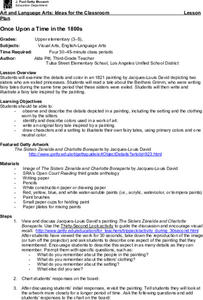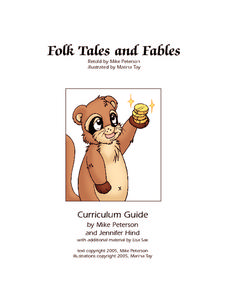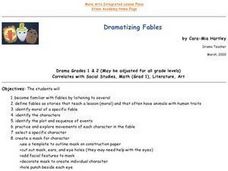Curated OER
Fairy Tales
Students research the Internet using hotlists to find two different versions of a fairy tale after watching a teacher presentation of two versions of The Three Little Pigs. They design a PowerPoint presentation that shows the comparisons...
Curated OER
Transforming Fairy Tales
Students use the computer to write, draw, explore the Internet, and combine all of these elements. They write their own fairy tales, use computer software to create drawings of the characters for their tales and use the Internet to...
Curated OER
Once upon a Time in the 1800's
Young readers examine the details in an 1821 painting by Jacques-Louis David depicting two sisters who are exiled princesses. They read a tale about the Brothers Grimm, who were writing fairy tales during the same time period that these...
Curated OER
Fantasy, Fables, Myths, Legends & Fairy Tales
Students identify the differences between fantasies, fables, myths, legends and fairy tales. In groups, they create their own versions of the different genres. They practice identifying the examples, as well.
Curated OER
The Coin and the Fable: Alaska quarter reverse
An Alaskan quarter and a book of fables is what you'll need to start this instructional activity. Learners will use the image of the bear and the salmon found on the reverse side of the Alaskan quarter as inspiration. They will compose a...
Weekly Story Book
Folk Tales and Fables
Pages and pages of engaging activities, worksheets, and writing projects on teaching folktales and fables await you! You don't want to miss this incredible resource that not only includes a wide range of topics and graphic...
Curated OER
Fairytale Favorites
Students access George MacDonald's Fairytales website, read exerpts of pre-selected tales, select their favorite and communicate that information via the internet to another class.
Curated OER
Storytelling
Students explore the origins of folktales, fairytales, myths, legends, fables, and folktales in the ten lessons of this unit. A storytelling festival is held to feature the results of the variety of activities presented in the unit.
Curated OER
Knights and Castles and Kings Galore
Fifth graders create a fairy tale story with emphasis on castles. After reading various texts featuring castles and their residents, 5th graders complete a book report project. The book report serves as a springboard to the writing...
Curated OER
I Hate to Complain but your Cheese Stinks
Students read and discuss the "fractured" fairy tale "The Stinky Cheese Man". They imagine that they are in the fairy tale and write a letter of complaint concerning the Cheese Man and how he stinks up the town.
Curated OER
Slimy Advertising and a Wicked Resume
Students compare and contrast a classic fairy tale with a fractured one. They write an advertisement that would entice a witch and a resume for a frog prince who is hiring. They publish their completed work.
Curated OER
Dramatizing Fables
Students familiarize themselves with fables by listening to several of them. They define fables. They identify the moral of a specific fable. They identify characters, plot and sequence of events. They create a mask of a character in a...
Curated OER
Goldilocks and the Three Bears
Learners print out the pictures of bears to retell the story of Goldilocks and the Three Bears. In this fable lesson, students use the bears to retell the fable story.
Montana State University
One Mountain, Many Cultures
Americans may think of Mount Everest as a region dedicated to adventurous hikers, but many cultures have flourished there! Learners read informative books, watch videos, participate in classroom discussion, analyze folk tales, and...
Curated OER
Nibble, Nibble, Little Mouse
Students complete activities to analyze points of view in different texts. In this point of view lesson, students read Hansel and Gretel and The Magic Circle and discuss the points of view. Students choose a character from the story and...
Curated OER
Tales From Around the World
Students read stories. In this culture lesson plan, students read stories from different regions around the world. Students look for each region on the map and listen for interesting cultural details in the story. Students then discuss...
Curated OER
Language Arts: A Hoe-Down Wedding Invitation
Students write wedding invitations for the fairy tale, Bubba, the Cowboy Prince. Once they assess the components of the original Cinderella story, they compare and contrast it with the fractured fairy tale. Students decorate their...
Curated OER
Personification Stories
Students create a clay object in which they are to personify. They use their own personal experiences to help the viewer imagine what it would be like to be that particular object. They also watch videos of fables to help them with...
Curated OER
Stories That Really Add Up
Students, in groups, develop math lessons for younger students that each stems from a popular student story. Group members individually develop lessons for other subject areas based on their group's story, creating interdisciplinary units.
Curated OER
Dalai Lama: Day 2 of 5
Sixth graders explore philosophy by researching the Dalai Lama. In this Tibetan history lesson plan, 6th graders discuss the influence of Buddhism on the Dalai Lama and the unique view on life a Buddhist must have. Students read a...
Curated OER
We're Building Heroes
Students discuss their ideas of the qualities a hero possesses. In this attributes of a hero lesson plan, students construct a hero puzzle and identify qualities of a hero in storybook characters.
Curated OER
Touring the World With Tomie dePaola
Students listen aloud to books by Tomie dePaola. They utilize the Internet to study the geography and culture of the places the they read about in Tomie dePaola's books. They answer questions about Norway through an Internet treasure hunt.
Curated OER
Kinder-Pictionary
Students create their own dictionary. In this spelling lesson, students make a dictionary with just words and pictures. They use these dictionaries when they are writing to remember how to spell words.
Curated OER
Earth Day
Third graders utilize technology to access, analyze, interpret and communicate information about Earth Day.























